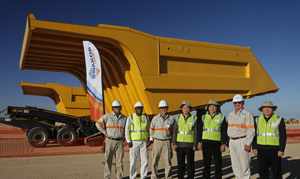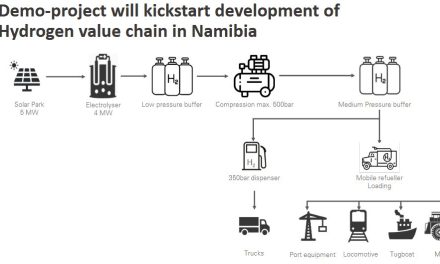
Colossal machinery to equally match colossal mining activities

And you thought your bakkie was big: Officials from Swakop Uranium stand in front of the huge the dump bodies which are to be linked to the trucks which are to work on the Husab Mine
Swakop Uranium, which is currently building what will be the world’s second biggest Uranium mine 70km from Swakopmund, will order 43 of these huge trucks of which eleven have already been assembled and are being used in the Husab mining operations, which started in March.
These massive trucks are almost a project within a project, mostly because their components are manufactured all over the globe before being shipped. It takes up to six months to manufacture the components, a month to transport them to the site and up to six weeks to assemble them.
The chassis are manufactured in America, the electric drive systems in Germany, the engines in the United Kingdom, the tyres in Japan and the dump bodies in South Africa. Once manufactured, the chassis, electric drive systems, transmissions and other components such as the engines, traction alternators, radiators, sub-frames, spindle hubs, brake assemblies, suspensions, axle boxes, blown grid assemblies and control cabinets are partly assembled at Komatsu’s Peoria Plant in Illinois, USA. From there, they are railed to the Port of Houston in Texas from where they are shipped to Walvis Bay.
In Walvis Bay, they meet with the enormous tyres, the first 160 of which have been shipped directly from the manufacturer, Bridgestone in Japan, to Walvis Bay since January 2013. From the Walvis Bay harbour, the components are transported to the Husab Project site, where they are “introduced” to the massive dump bodies. The dump bodies (which are the bins on the back that carry the ore), are manufactured under licence by Efficient Engineering in Johannesburg and brought to site by road.
The first to give light on the very real and very big yellow machines which are to start the excavation of the two mining pits, was Rainer Horsthemke, Swakop Uranium’s Operational Readiness & Services Manager, “Phase 2 of the haul truck assembly has started and we have a tight deadlines to meet and deadline will see the delivery of another 12 haul trucks to the mining teams by the end of the year,” said Rainer. The Komatsu 960E-2KT haul truck is the biggest made by the Japanese company and is rated to carry 327 tonnes. Its diesel motor delivers 2,600 kW of power (3,500 horsepower) and is coupled to an alternator that sends power to two Siemens AC induction traction motors mounted on each side of the back axle.
The “T” in the model name refers to “trolley-assist”, whereby the truck can couple onto overhead power lines using a pantograph mounted above the cab.
“We receive each Komatsu haul truck in sections comprising the chassis with the engine, radiator and rear axle box fitted. This section alone weighs 64 tonnes,” Rainer explained. “The rest of the truck then arrives in five open-topped 12m containers with a few items such as the fuel tank, braking system and transmission packaged separately.”
“Construction of the Husab Mine is progressing on target. Once in full production, Husab has the potential to produce 15 million pounds (6 800 tonnes) of uranium oxide (also called yellow cake) per annum,” he said Swakop Uranium’s order for the Komatsu 960E-2KT haul trucks was the single largest ever received by Komatsu Southern Africa. Swakop Uranium also ordered four hydraulic face shovels, nine drill rigs and a variety of other ancillary equipment for the Husab Mine.















































